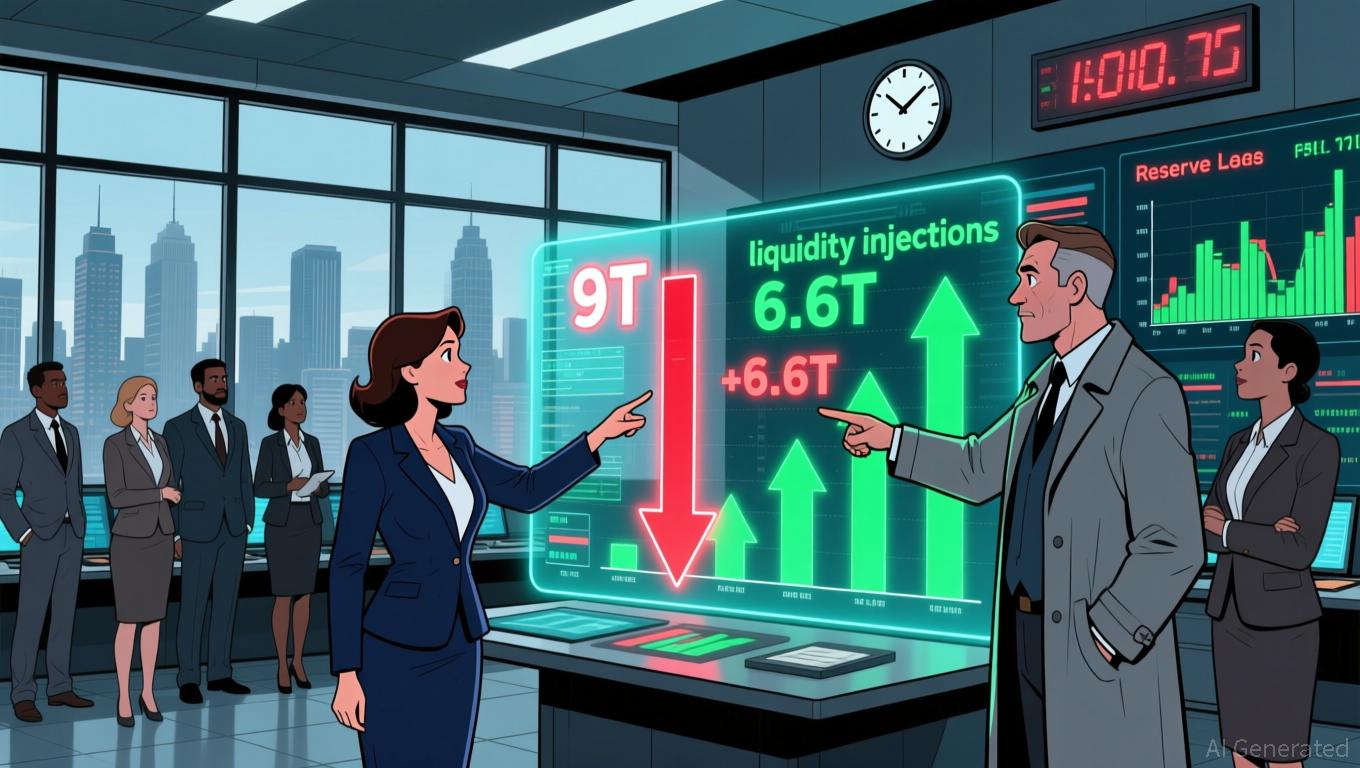Fed Faces a Pivotal Choice: Managing Liquidity or Controlling Inflation
- Fed may expand balance sheet to address liquidity needs amid shrinking reserves, signaling potential end to 3-year QT program. - Officials pause QT as $6.6T reserves deemed "somewhat above ample," but warn of risks from inflation above 2% target and market volatility. - Governor Mester cautions against aggressive rate cuts, citing economic rebound risks and fiscal/regulatory factors boosting 2026 growth outlook. - External pressures including government shutdown delays and stablecoin demand growth compli
The Federal Reserve is at a critical crossroads as it works to strike a balance between ensuring sufficient liquidity and keeping inflation in check. In a recent speech, John Williams, President of the New York Fed, discussed the possibility that the central bank could soon move to increase its balance sheet—a step that would mark a departure from its prolonged period of quantitative tightening (QT).

The Fed’s recent decision to halt QT, announced last week, signals its view that current reserve levels are adequate to keep money markets steady without providing too much stimulus. Williams stated that the three-year process of reducing the balance sheet “has gone as planned,” but he also emphasized the need to keep a close watch on market shifts to identify when reserves might reach “ample” territory
Elsewhere, Federal Reserve Governor Loretta Mester has urged caution regarding aggressive rate cuts in December, suggesting that the economy is set for a recovery in early 2026. Mester cited factors such as government spending, regulatory adjustments, and the delayed impact of earlier rate hikes as key influences. However, she cautioned that further rate reductions could risk overheating the economy, especially since inflation remains above the Fed’s 2% goal. Her remarks reflect a broader hesitancy among policymakers, who have indicated a preference for a gradual approach to loosening policy
The Fed’s efforts are further complicated by outside influences, including geopolitical tensions and unpredictable markets. For example, the recent U.S. government shutdown interrupted the release of economic data, making the Fed’s policy decisions more challenging. Analysts at First Abu Dhabi Bank observed that such disruptions could prompt the Fed to postpone rate cuts in December to maintain its policy credibility
Market responses to these developments have been varied. While the Fed’s pause in QT has brought some stability to money markets, digital assets have seen significant outflows, with
As the Fed looks ahead to its next policy meetings, attention will remain on how effectively it can address these complex challenges while upholding its dual mandate of price stability and full employment. The way forward will depend on ongoing evaluations of reserve requirements, market dynamics, and the shifting economic environment.
Disclaimer: The content of this article solely reflects the author's opinion and does not represent the platform in any capacity. This article is not intended to serve as a reference for making investment decisions.
You may also like
Top 5 Cryptos Soaring as U.S. Government Shutdown Ends
Zcash (ZEC) Rises Sharply: Is This the Dawn of Privacy-Focused Cryptocurrency?
- Zcash (ZEC) surged 425% in 2025, trading at $528.95 as of November 6, driven by whale activity, DeFi integration (e.g., zenZEC), and rising privacy demand. - Regulatory challenges loom, with EU rules banning privacy coins by 2027 and U.S. enforcement actions targeting unlicensed privacy tools, complicating ZEC's compliance. - ZEC's hybrid model (transparent/shielded transactions) and institutional interest (e.g., BitMEX co-founder's portfolio) suggest potential for niche adoption amid regulatory tensions
Zcash Halving and Its Impact on the Market: Deflationary Features of Blockchain and Speculative Behavior of Investors
- Zcash's 2025 halving reduces block rewards by 50%, tightening supply and mirroring Bitcoin's deflationary model. - Historical data shows 500%+ price surges post-halving, with Grayscale's $137M Zcash Trust signaling institutional interest. - Privacy-focused shielded transactions (28% of supply) decouple demand from speculation, enhancing long-term utility. - Speculative FOMO drives ZEC's 1,172% YTD surge, while inverse Bitcoin dynamics attract investors during crypto downturns. - Risks include regulatory

Zcash (ZEC) Price Rally: Essential Insights for Privacy Coin Investors
- Zcash (ZEC) surged 472% in late 2025 to $420, driven by institutional adoption and privacy-focused innovation. - Grayscale invested $137M in ZEC via ZCSH, leveraging its optional transparency model to navigate AML regulations. - U.S. Clarity/Genius Acts provided legal clarity for privacy coins, while Zenrock’s zenZEC bridged privacy and DeFi. - Zcash’s 150% QoQ on-chain growth and institutional endorsements position it as a privacy-first alternative to Bitcoin . - Regulatory risks persist, but Zcash’s hy
